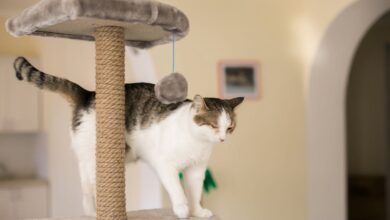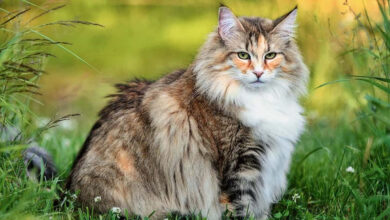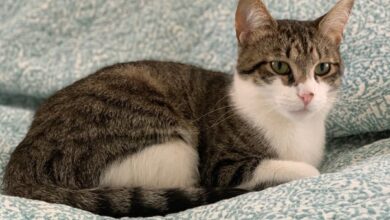The Majesty of Maine Coons

Frequently Asked Questions (FAQ)
Why are Maine Coon Cats so Big?
There are a few key biological reasons why Maine Coons grew to become the largest domesticated cat breed:
- Natural Selection – Early Maine Coons evolved in a harsh New England climate requiring extra insulation and size to survive long, snowy winters. Bigger cats were better adapted.
- Purposeful Breeding – Once their qualities were recognized, breeders emphasized traits like weight, coat thickness, and tail length through the selective pairing of the biggest furriest specimens.
- Giantism Gene – Scientists have identified a mutation in the insulin-like growth factor 1 (IGF1) gene in Maine Coons and some other large cat breeds, which promotes exceptional size.
- Polar Bear Ancestry Theory – Some experts speculate their ancestry may include crosses with local fisher cats or lynxes, introducing genes for giantism carried over from prehistoric polar bear hybridization many centuries ago.
- Low Growth Hormone Levels – Analysis shows mature Maine Coons have lower levels of Growth Hormone (GH) versus other breeds, allowing them to achieve great size without becoming obese.
So in essence, millennia of natural and later artificial selection have optimized the Maine Coon genome for maximized weight, length, and coat insulation – creating the majestic giants they are today!
How Long Can a Maine Coon Cat Live?
When well cared for with preventative health measures like annual checkups and proper diet, Maine Coons have an impressively long lifespan potential:
- The average lifespan is 12-15 years.
- However, many cats live to 18-20 years old, which is considered equivalent to a human lifespan of 90-100 years.
- The recognized longevity record for a Maine Coon is an incredible 25.5 years!
Several factors influence their longevity:
- Genetics – Some bloodlines simply age more gracefully through generations of selective breeding.
- Nutrition – A balanced raw or high-quality kibble diet tailored to its large size prevents obesity and associated health issues.
- Indoor lifestyle – Being indoor pets helps avoid accidental injury or disease transmission from wildlife.
- Vaccinations – Yearly shots guard against fatal infectious feline illnesses.
- Spaying/neutering – Eliminates risks from reproductive cancers and increases wellness.
So with responsible care Maine Coons have the potential for a remarkably long and happy retirement well into their second decade of life. Their calm nature also makes senior years very enjoyable.
What Do Maine Coons Eat?
Given their impressive size, it’s no surprise that Maine Coons have significantly higher caloric and nutrient needs compared to smaller breeds. Here are some feeding guidelines:
- Adult Maintenance – Most adults do well on 1-2 cups of premium wet or dry food divided into two meals daily. Wet food is preferable due to its higher moisture content.
- Kitten Growth – Kittens require significantly more calories and should have unlimited access to quality kitten food. Feed 3-5 times daily until six months old.
- Weight Gain – For pets that are underweight, boil chicken breast or salmon in water and blend into a puree to add calories easily to regular meals. Monitor weight closely.
- Senior Years – As metabolism slows, reduce portions by 10-15% to prevent obesity which can exacerbate arthritis or organ issues later on.
- Special Diets – For health conditions like urinary or kidney issues, consult your vet about prescription therapeutic diets tailored for Maine Coons.
- Human Food – In moderation, Maine Coons often enjoy small portions of boiled chicken, salmon or tuna as a treat. But avoid dairy, wheat, sugar, or excess fat.
The key is meeting their caloric needs through consistent, nutrient-dense meals while avoiding obesity. With care, Maine Coons will thrive on an appropriate feeding plan matched to their life stage and condition.
What is the Biggest Cat Breed?
While Maine Coons routinely rank among the largest domestic cats, there are a couple of breeds that occasionally produce outsized “giant” specimens surpassing even the biggest Maine Coons on record.
- Norwegian Forest Cat – Can match Maine Coon weights but rarely exceed 17 lbs (7.7 kg). Considered the second largest overall.
- Ragdoll – Fully grown males average 11-15 lbs (5-6.8 kg) but have been documented up to 22 lbs (10 kg) in rare outliers.
- Savannah – A wild-domestic hybrid resulting from crosses between Servals and domestic cats. Some large F1 males exceed even Maine Coons at 26+ lbs (11.8+ kg)!
However, the breed recognized by cat registries worldwide as holding the verified record for largest domestic cat is still…
- Maine Coon – The largest documented was a male named Hercules, who weighed an astonishing 27.1 lbs (12.3 kg) as an adult.
So while other large pedigree breeds may produce the occasional giant, Maine Coons maintain the official size record and routinely rank as the largest Natural domesticated cat on average due to their adaptability for superior size through natural selection over several centuries.
Why do Maine Coons Like Water?
An endearing quirk of the Maine Coon breed is their affinity and comfort level with water, unusual for domestic cats who typically dislike getting wet. A few theories explain their tolerance:
- Close genetic ties to wild lynx and bobcat ancestors adapted for water, such as fishing or swimming as a means of hunting prey.
- Early Maine Coon ancestors living near coastal Maine may have developed waterproofing to withstand ocean spray or rain as working ships’ cats.
- Their dense, water-resistant double coat sheds water easily without becoming soaked like most cats’ short, dense fur.
- Many enjoy drinking from running taps or accompanying owners into the shower, perhaps seeing it as play rather than something to avoid.
While not all Maine Coons actively seek out water play, most will tolerate occasional baths without distress, and some positively love swimming, splashing, or surfing along bath edges like little furry otters. Their curious, easygoing personalities predispose them to having fun in the water rather than fearing it.
Why is it Called a Maine Coon?
There are a few theories behind the name “Maine Coon”:
- Raccoon-like tail – When Europeans first encountered the breed, they recognized its bushy tail resembled a native raccoon, calling it a “Maine raccoon cat.” Over time this was shortened to Maine Coon.
- Coonskin trading – Pioneers in Maine traded fur pelts, including raccoons. It’s possible the early longhaired cats were connected to the coonskin hat trade and associated with the state of Maine, where they originated.
- Coon dog reference – “Coon” was historic American slang for any long-furred variety of hunting dogs. The early longhaired wild cats resembled rangy hunting hounds or dogs rather than other domestic cats.
- Northeastern colloquialism – A now outdated American term, “coon” was used to refer to anything from that region, like “Down East coon” so it was a cat indigenous to Maine.
Maine Coon cats are one of the largest domesticated cat breeds in the world. Their lumbering size, silky fur, and affectionate nature make them a unique and fascinating pet.
A Brief History of the Maine Coon Breed
The history of the Maine Coon cat spans centuries. Though the exact origins are unclear, most experts trace the breed’s ancestry back to native cats brought over to North America by early European settlers in the 17th century. Ship crews, traders, and trappers would often have cats on board to control rodents, and many cats either escaped or were left behind as settlers moved further inland along the coast of northern New England.
Over generations of isolation, the cats developed into a distinct population that was well-adapted to the harsh winters and rural lifestyle of Maine. Through natural selection, they grew large and stocky with thick, water-resistant fur ideal for surviving the cold, wet climate. Local seafarers took a liking to the self-sufficient cats and began selectively breeding them for companionship on long ocean voyages.
By the late 1800s, the distinctive traits of the Maine Coon breed were clearly established. However, it wasn’t until the 1960s that formal breed recognition came about through dedicated breeding programs and cat show participation. Today, the Maine Coon is one of the most popular pedigreed cats in North America and parts of Europe. Their gentle giants are cherished family pets renowned for their intelligence, loyalty, and affectionate nature.
Maine Coon Cat Breeds
While the classic brown tabby coat coloring is instantly recognizable as the traditional Maine Coon look, the breed actually has a wide variety of accepted coat patterns:
Tabby – The classic brown or gray ticked tabby pattern is iconic but also comes in silver, brown, black and blue shades.
Smoke – A light undercoat with darker tips creates a light gray appearance. Comes in charcoal, blue, lilac, and cream hues.
Solid – Ranges from white, cream, cinnamon, and chocolate solids.
Calico/Tricolour – White with orange and black or grey patching. Calicos are almost always female.
Bi-colour/Van – A combination of two contrasting colors like black and white.
Lynx Point – Tabby markings but with lighter undercoat color and darker points.
Tortoiseshell – Black patches combined with orange or cream in complex patterns.
This wide variety ensures there is a Maine Coon coat for every taste. Their captivating looks are matched by wonderful personalities across all colors and patterns.
Maine Coon Physical Characteristics
Maine Coons have a distinctively large and powerful build clearly adapted for cold weather survival. Their most notable physical traits include:
Size
Maine Coons are the largest domesticated cat breed. On average, males can weigh between 6-18 kgs and females 4-11 kgs as full-grown adults.
Length
From nose to tail tip, males typically range 70-90cm long while females are slightly smaller at 60-80cm.
Tail
Probably their most iconic feature is the bushy raccoon-like tail, which is often longer than their body. This adds 5-15cm to their overall length.
Coat
They have a thick double coat made for insulation. The water-resistant topcoat lies over a soft downy undercoat. Hair can be long or short, depending on the individual cat.
Paws
With broad heavy-set paws and toes like snowshoes, Maine Coons are well-balanced for walking on snow or ice.
Ears
Tufted ears with lynx-like tips give them a very regal profile and aid in retaining body heat.
Facial ruff
Many Maine Coons also have a pronounced “mane” ruff around their neck and shoulders, adding to their impressively furry appearance.
Temperament
Despite their formidable size, they have gentle souls with calm, affectionate, and tolerant natures ideally suited for family pets.
Maine Coon Cats Size Comparison
To truly appreciate how massive Maine Coons can become, here is a size comparison to other cats:
Domestic Shorthair
The most common housecat breed weighing between 3-5kgs on average is significantly smaller than a typical Maine Coon.
Norwegian Forest Cat
Another large natural breed comparable to small-medium Maine Coons but rarely reaching the weights of the largest stud males.
Siberian Cat
Similar very chill temperament but slightly smaller than an average Maine Coon with less dense coat genetics on average for warmer climates.
Ragdoll
A big lazy lap cat, however, males usually max out at 9-11kgs, so they are still smaller-boned than a large Maine Coon buck.
Savannah
These sleek cheetahs resemble a small-medium Maine Coon in stature despite being a crossbreed rather than a natural breed.
So, in summary, a fully grown male Maine Coon is capable of being nearly three times the size of many common housecat breeds with a presence matching their legendary proportions.
Maine Coon Cats Size in Feet
Seeing as many homes and pieces of furniture are measured in feet or meters, here is a size reference for Maine Coons in these terms:
- Average male Maine Coon standing height at the shoulder is 15-20 inches or 38-51 cm.
- Females generally 13-18 inches or 33-46 cm tall.
- From nose to tail tip, males can stretch 4-5 feet or 122-152 cm long.
- Females around 3-4.5 feet or 91-137 cm nose to tail.
- Their tail alone often spans 1-2 feet or 30-61 cm beyond the rump.
- Paws may be 4-6 inches or 10-15 cm across, similar to the span of a human hand.
So, in summary, a mature male Maine Coon is comparable in height to a small child when standing on their hind legs. Laid out, they could stretch from one end of a single bed to the other! Their abundant fur and tail only enhance this magnificent stature.
Regardless of the exact origin, the thick coat and raccoon resemblance are what stuck in cementing their charming association with pine trees and coastlines of their namesake state of Maine, where the breed was refined.



